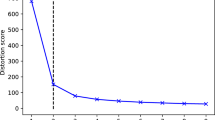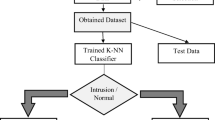Abstract
A mobile ad hoc network (MANET) does not have traffic concentration points such as gateway or access points which perform behaviour monitoring of individual nodes. Therefore, maintaining the network function for the normal nodes when other nodes do not forward and route properly is a big challenge. One of the significant attacks in ad hoc network is wormhole attack. In this wormhole attack, the adversary disrupts ad hoc routing protocols using higher bandwidth and lower-latency links. Wormhole attack is more hidden in character and tougher to detect. So, it is necessary to use mechanisms to avoid attacking nodes which can disclose communication among unauthorized nodes in ad hoc networks. Mechanisms to detect and punish such attacking nodes are the only solution to solve this problem. Those mechanisms are known as intrusion detection systems (IDS). In this paper, the suggested biological based artificial intrusion detection system (BAIDS) include hybrid negative selection algorithm (HNSA) detectors in the local and broad detection subsection to detect anomalies in ad hoc network. In addition to that, response will be issued to take action over the misbehaving nodes. These detectors employed in BAIDS are capable of discriminating well behaving nodes from attacking nodes with a good level of accuracy in a MANET environment. The performance of BAIDS in detecting wormhole attacks in the background of DSR, AODV and DSDV routing protocols is also evaluated using Qualnet v 5.2 network simulator. Detection rate, false alarm rate, packet delivery ratio, routing overhead are used as metrics to compare the performance of HNSA and the BAIDS technique.














Similar content being viewed by others
References
Zhang, Y., Lee, W., & Huang, Y. (2003). Intrusion detection techniques for mobile wireless networks. ACM Wireless Networks Journal, 5, 545–556.
Lau, F., Rubin, S. H., & Smith, M. H. (2000). Distributed denial of service attacks. In Proceedings of the IEEE International Conference on Systems, Man, and Cybernetics (pp. 2275–2280).
Ou, C.-M. (2012). Host-based intrusion detection systems adapted from agent-based artificial immune systems. Journal of Neurocomputing, 88, 78–86.
Gonzalez, F. A., & Dasgupta, D. (2003). Anomaly detection using real-valued negative selection. Journal Genetic Programming and Evolvable Machines, 4, 383–403.
Dasgupta, D., & Gonzalez, F. (2002). An immunity based technique to characterize intrusions in computer networks. IEEE Transactions on Evolutionary Computation, 3, 281–291.
De Castro, L. N., & Timmis, J. (2002). An introduction to artificial immune systems: A new computational intelligence paradigm. In Proceedings of IEEE Congress on Evolutionary Computation (pp. 699–674).
Azandaryani, A. H. M., & Meybodi, M. R. (2009). A learning automata based artificial immune system for data classification. In Proceedings of IEEE Computer Conference (pp. 530–535).
Sompayrac, L. M. (2003). How the immune system works (2nd ed.). Oxford: Blackwell.
Sarafijanovic, S., & Le Boudec, J.-Y. (2005). An artificial immune system approach with secondary response for misbehavior detection in mobile ad hoc networks. IEEE Transactions on Neural Networks, 5, 1076–1087.
Forrest, S., Perelson, A. S., Allen, L., & Cherukuri, R. (1994). Self-nonself discrimination in a computer. In Proceedings of the IEEE Symposium on Research in Security and Privacy (pp. 202–212). IEEE Computer Society Press.
Hofmeyr, S., & Forrest, S. (1999). Immunity by design: An artificial immune system. In Proceedings of Genetic and Evolutionary Computation Conference (pp. 1289–1296).
Kim, J., & Bentley, P. (2001). An evaluation of negative selection in an artificial immune system for network intrusion detection. In Proceedings of the Genetic and Evolutionary Computation Conference, Morgan Kaufmann (pp. 1330–1337).
Ji, Z., & Dasgupta, D. (2009). V-Detector: An efficient negative selection algorithm with probably adequate detector coverage. Information Sciences, 179(10), 1390–1406.
Balachandran, S., Dasgupta, D., & Wang, L. (2006). A hybrid approach for misbehavior detection in wireless ad-hoc networks. Published in Symposium on Information Assurance.
Padmaja, G. M., & Rajya lakshmi, C. H. (2012). Analyzing the detection of active attacks in wireless mobile networks. International Journal of Reviews in Computing, 9, 34–38.
Johnson, D., Maltz, D., & Hu, Y. C. (2003). The dynamic source routing protocol for mobile ad hoc networks (DSR). Internet Engineering Task Force Internet draft, draft-ietf-manet-dsr-09.txt.
Razak, S. A., Furnell, S. M., Clarke, N. L., & Brooke, P. J. (2008). Friend-assisted intrusion detection and response mechanisms for mobile ad hoc networks. Journal on Ad Hoc Networks, 7, 1151–1167.
Su, M.-Y., Chiang, K.-L., & Liao, W.-C. (2010). Mitigation of black-hole nodes in mobile ad hoc networks. In ISPA Proceedings of the International Symposium (pp. 162–167).
Jayashree, P., & Easwarakumar, K. S. (2010). User behaviour trust model to defend denial of service attacks in distributed computational environments. International Journal of Communication Networks and Distributed Systems, 3, 279–294.
QualNet 4.5.1 (2008). Programmer’s guide. Scalable Network Technologies, Inc.
Perkins, C., Royer, E., & Das, S. (2002). Ad hoc on-demand distance vector (AODV) routing. Internet Draft, draft-ietf-manet-aodv-11.txt.
Pirzada, A. A., Portmann, M, & Indulska, J. (2006). Performance comparison of multi-path AODV and DSR protocols in hybrid mesh networks. In IEEE International Conference on Networks (ICON 2006) (pp. 1–6).
Hu, Y.-C., Johnson, D. B., & Perrig, A. (2003). SEAD: Secure efficient distance vector routing for mobile wireless ad hoc networks. Ad Hoc Networks, 1(1), 175–192.
Michiardi, P., & Molva, R. (2002). Core: A collaborative reputation mechanism to enforce node cooperation in mobile ad-hoc networks. In Proceedings of the 6th IFIP Communication and Multimedia Security Conference (pp. 107–121).
Author information
Authors and Affiliations
Corresponding author
Rights and permissions
About this article
Cite this article
Sundararajan, T.V.P., Ramesh, S.M., Maheswar, R. et al. Biologically inspired artificial intrusion detection system for detecting wormhole attack in MANET. Wireless Netw 20, 563–578 (2014). https://doi.org/10.1007/s11276-013-0623-8
Published:
Issue Date:
DOI: https://doi.org/10.1007/s11276-013-0623-8




